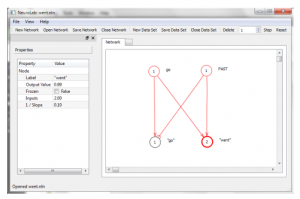I have made a new release (v1.0.3) of the Neurocognitive Linguistics Laboratory software.
The program is available for Windows, Mac OS X and Linux at:
http://bitbucket.org/kulibali/neurocogling/downloads
PLEASE NOTE: if you used the v1.0.2 Windows installer to install v1.0.2, please uninstall it before installing v1.0.3.
This update contains a few bug fixes and some internal improvements:
- Link rendering is more friendly and efficient.
- Plugins can now be loaded on OS X.
- Bug fix: fixed crash when loading files containing self-links.
- Bug fix: fixed crash when creating new items after multiple items were selected.
Please see the changelog for further details:
http://bitbucket.org/kulibali/neurocogling/wiki/Changelog
The Neurocognitive Linguistics Lab (“NeuroLab” for short) is a program that allows you to experiment with the relational networks of Sydney Lamb’s neurocognitive linguistics model using a convenient GUI, and record the results of your experiments in tabular form.
